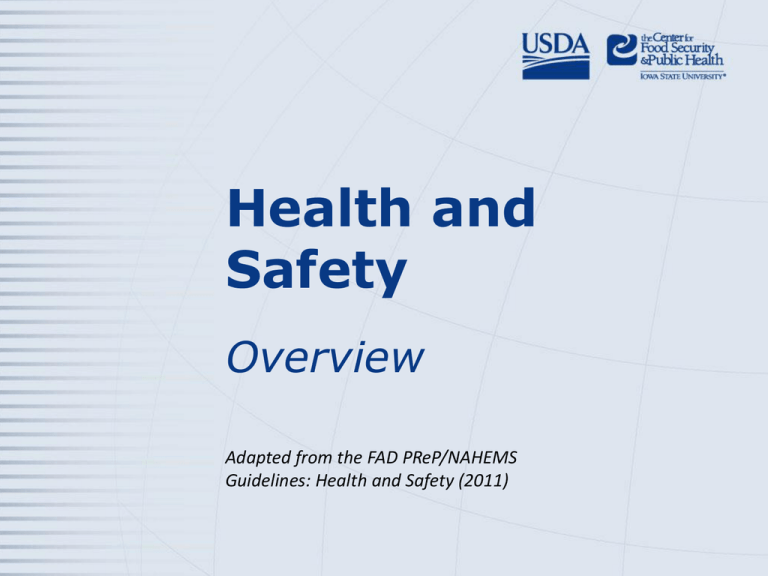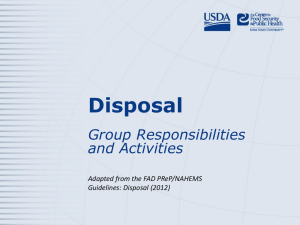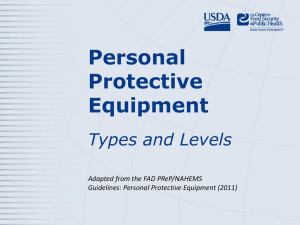Health and Safety Overview Adapted from the FAD PReP/NAHEMS
advertisement

Health and Safety Overview Adapted from the FAD PReP/NAHEMS Guidelines: Health and Safety (2011) This Presentation • Roles and responsibilities – Responders, ICS Staff • • • • Pre-deployment preparation Hazards during deployment Responder security and safety Incident reporting FAD PReP/NAHEMS Guidelines: Health and Safety - Overview USDA APHIS and CFSPH Roles and Responsibilities FAD PReP/NAHEMS Guidelines: Health and Safety - Overview USDA APHIS and CFSPH Statutory Authority • APHIS Directive 6800.1: – Ensuring the Protection of Employees Involved in Highly Pathogenic Avian Influenza Control and Eradication Activities • Occupational Safety and Health Act of 1970 – Employment and place of employment – Free from recognized hazards that may cause or are likely to cause death or serious physical harm FAD PReP/NAHEMS Guidelines: Health and Safety - Overview USDA APHIS and CFSPH Incident Command System • Incident Commander – Overall management • Safety Officer – Identify hazards – Establish safe work procedures – Communicate health and safety information – Has authority to issue immediate stop work order to halt unsafe activities FAD PReP/NAHEMS Guidelines: Health and Safety - Overview USDA APHIS and CFSPH Worker Responsibilities • Awareness of your health status and physical limits • Follow safe work procedures • Correctly use Personal Protective Equipment (PPE) • Report unsafe actions and conditions • Report all injuries to supervisors FAD PReP/NAHEMS Guidelines: Health and Safety - Overview USDA APHIS and CFSPH Pre-Deployment Preparation FAD PReP/NAHEMS Guidelines: Health and Safety - Overview USDA APHIS and CFSPH Personal Health • Physical Exam • Vaccinations – Rabies – Influenza – Tetanus/diphtheria – Pneumococcal • Chronic disease • Pregnancy • Medications FAD PReP/NAHEMS Guidelines: Health and Safety - Overview USDA APHIS and CFSPH Training • Incident Command System Training • USDA APHIS Emergency Deployment Generic Health and Safety Plan (HASP) • http://www.aphis.usda.gov/emergency_response/hasp/ health_safety_hs_training.shtml • OSHA - HAZWOPER Training – HAZardous Waste OPerations and Emergency Response – Training level based on duties and functions • Additional training FAD PReP/NAHEMS Guidelines: Health and Safety - Overview USDA APHIS and CFSPH Health and Safety Briefing • Arrival at incident site – Check in and receive orientation packet • Initial on-site briefing – Incident Health and Safety Plan – Standard operating procedures – Job Hazard Analysis – Emergency procedures – Contingency plans • Daily safety briefings FAD PReP/NAHEMS Guidelines: Health and Safety - Overview USDA APHIS and CFSPH Hazards During Deployment FAD PReP/NAHEMS Guidelines: Health and Safety - Overview USDA APHIS and CFSPH Work Settings/Shifts • Extended and unusual shifts • Fatigue, stress, reduced concentration • Know your limits • Manage work and rest periods FAD PReP/NAHEMS Guidelines: Health and Safety - Overview USDA APHIS and CFSPH Physical Hazards • Animal related incidents – Injuries, zoonoses – Insects, wild animals • Musculoskeletal injuries – Strains, sprains, ergonomic injury – Back injuries • Slips, trips and falls • Sharps FAD PReP/NAHEMS Guidelines: Health and Safety - Overview USDA APHIS and CFSPH Environmental Hazards • Temperature/Weather – Heat and cold • Noise – Animal vocalization, power tools, heavy equipment • Electrical Shock • Chemical Exposure – Animal waste gases, carbon monoxide, disinfectants FAD PReP/NAHEMS Guidelines: Health and Safety - Overview USDA APHIS and CFSPH Psychological Hazards • Stress – Fatigue – Anxiety – Anger – Depression • Ways to reduce stress – Monitor for signs – Take frequent rest breaks FAD PReP/NAHEMS Guidelines: Health and Safety - Overview USDA APHIS and CFSPH Responder Security and Safety FAD PReP/NAHEMS Guidelines: Health and Safety - Overview USDA APHIS and CFSPH Site Security and Safety • Work zones – Control access to work site – Prevent unauthorized persons – Limit spread of hazardous materials or disease agents FAD PReP/NAHEMS Guidelines: Health and Safety - Overview USDA APHIS and CFSPH Responder Safety • Accountability – Personnel must be accounted for at all times – Check-in and check-out – Notify supervisor when leaving • Buddy system – Work in pairs – Observe each other • Medical monitoring FAD PReP/NAHEMS Guidelines: Health and Safety - Overview USDA APHIS and CFSPH Contingency Plans • Events – Fire, explosion, hazardous material, severe weather • Response – Evacuation • Pre-determined signal and site • Ensure all are accounted for – Shelter-in-place • Pre-determined locations • Remain until “all clear” is given – Emergency medical assistance network FAD PReP/NAHEMS Guidelines: Health and Safety - Overview USDA APHIS and CFSPH Incident Reporting FAD PReP/NAHEMS Guidelines: Health and Safety - Overview USDA APHIS and CFSPH Incident Reporting • Notify supervisor immediately • Complete Incident Report – – – – – Date, time and place Person(s) involved Type of incident Description Recommendations • Report by phone within 2 hours of incident • Written report within 5 days of incident FAD PReP/NAHEMS Guidelines: Health and Safety - Overview USDA APHIS and CFSPH Workers’ Compensation • Government employees • Report injuries as soon as possible – Time limits for reporting claims – Be aware of filing deadlines FAD PReP/NAHEMS Guidelines: Health and Safety - Overview USDA APHIS and CFSPH For More Information • FAD PReP/NAHEMS Guidelines & SOP: Health & Safety (2011) – http://www.aphis.usda.gov/animal_ health/emergency_management/ • Health and Safety web-based training module – https://naherc.sws.iastate.edu/ FAD PReP/NAHEMS Guidelines: Health and Safety - Overview USDA APHIS and CFSPH Guidelines Content Author (CFSPH) • Cheryl L. Eia, JD, DVM, MPH Reviewers (USDA) • Lori P. Miller, PE • Peter A. Petch, RPIH, CIPS, CIMT, CHS-V • Thomas R. Walker, MD FAD PReP/NAHEMS Guidelines: Health and Safety - Overview USDA APHIS and CFSPH Acknowledgments Development of this presentation was by the Center for Food Security and Public Health at Iowa State University through funding from the USDA APHIS Veterinary Services PPT Authors: Dawn Bailey, BS; Kerry Leedom Larson, DVM, MPH, PhD, DACVPM; Patricia Futoma, Veterinary Student Reviewers: Glenda Dvorak, DVM, MPH, DACVPM; Janice Mogan, DVM

